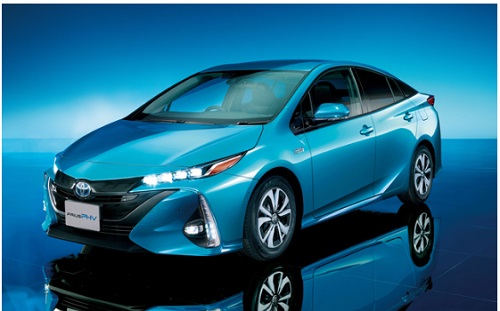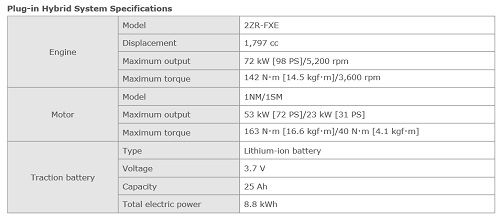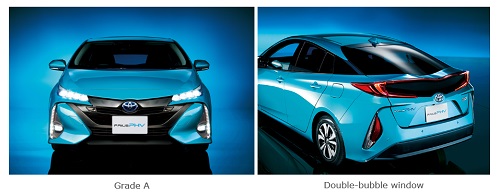|
Toyota Launches Redesigned "Prius PHV" in Japan
As the of 68.2 km, more than double that of its predecessor
Toyota City, Japan, Feb 15, 2017 - (JCN Newswire) - Toyota Motor Corporation announces the launch of the redesigned Prius PHV in Japan, and sales will begin at all Toyota, Toyopet, Toyota Corolla and Netz dealers nationwide on February 15.
 | | Grade A | | |
 | | Manufacturer's suggested retail prices | | |
 | | Manufacturer's Suggested Retail Prices for Welcab Variants | | |
 | | Plug-in Hybrid System Specifications | | |
 | | Charging methods and time needed | | |
 | | Grade A; Double-bubble window | | |
- EV mode range expanded to 68.2 km(1). Achieves high fuel efficiency of 37.2 km/L(2) as a hybrid vehicle even after the battery has been depleted.
- Users can choose from a variety of charging methods: normal charging (200V or 100V), quick charging(3), and solar charging system(4).
- Safe, secure, and convenient navigation service, T-Connect, has been provided using the Toyota-first 11.6-inch T-Connect SD navigation system(5) and DCM5(6).
Toyota has been working on enhancing its product lineup significantly, and is positioning plug-in hybrid vehicles (PHVs) as the pillar of next-generation environmental vehicles after hybrid vehicles (HVs).
With the new Prius PHV, Toyota has greatly advanced on the environmental performance that is characteristic of the Prius lineup, along with the powerful and smooth drive which is an attribute of an electric vehicle (EV). Futuristic advanced equipment has been added and charging convenience greatly improved, thus evolving the new Prius PHV into a prime vehicle.
During short-distance drives, such as daily commuting and shopping trips, a plug-in hybrid operates as an electric vehicle (EV) and does not consume any gasoline. At the same time, it can be driven over long distances as a hybrid vehicle (HV) even after the battery charge is depleted. Toyota positions PHVs as the core vehicle segment in the company's Toyota Environmental Challenge 2050-where the goal is to achieve a society in which cars, people and the environment co-exist harmoniously - and plans to continue strengthening this product line.
In January 2012, Toyota launched the Prius PHV with the goal of promoting vehicle electrification. To date, sales of the Prius PHV have totaled approximately 22,000 units in Japan, and approximately 75,000 units worldwide, including the U.S. and Europe.
http://www.acnnewswire.com/topimg/Low_ToyotaPriusGradeA.jpg
Grade A
New Welcab versions (special features have been installed by Toyota) will also be launched in April. A new model with a rotating and tilting front passenger seat makes it easier for a person requiring assistance to get in and out of the vehicle, thus easing the burden on the caregiver.
Monthly sales target for Japan
2,500 units
Assembly plant
Tsutsumi plant, Toyota Motor Corporation
Manufacturer's suggested retail prices
http://www.acnnewswire.com/topimg/Low_ToyotaPriusRetailPrices.jpg
Manufacturer's Suggested Retail Prices for Welcab Variants
http://www.acnnewswire.com/topimg/Low_ToyotaPriusRetailPricesWelcab.jpg
Vehicle Outline
1. Fusion of Environmental Performance and Driving Performance
- The use of a large-capacity, lithium-ion battery, combined with efficiency improvements in the plug-in hybrid system, has increased the EV mode range to 68.2 km and the maximum EV mode speed to 135 km/h7, thus greatly expanding the electric-only range.
- The Prius PHV also features a dual motor drive system, using both the electric motor and the generator as the drive force, to achieve powerful acceleration performance.
- The use of a dedicated heater for the traction battery and the world's first8 automatic air conditioner with a heat pump and gas injection function which helps prevent the engine from coming on during EV mode operation.
- The 1.8-liter high-efficiency engine achieves a high hybrid fuel efficiency of 37.2 km/L.
Plug-in Hybrid System Specifications
http://www.acnnewswire.com/topimg/Low_ToyotaPriusPulginHybrid.jpg
2. Enhanced Charging System
-Standard charging uses AC100V/6A from a standard household outlet and it therefore requires no special wiring9. Outside of the home, the Prius PHV can be charged at Toyota dealers (approximately 4,200 charging stations10) and at any of the charging spots (approximately 14,600 spots11) operated by Nippon Charge Service LLC (Minato-ku, Tokyo)11.
Charging methods and time needed
http://www.acnnewswire.com/topimg/Low_ToyotaPriusChargingMethods.jpg
- The Prius PHV features the world's first8 "solar charging system" in mass-produced cars. This system supplies energy from sunlight to the traction battery while the vehicle is parked, supplying the amount of electricity sufficient for driving the vehicle a maximum of around 6.1 km/day (approximately 2.9 km/day on average)13. While the vehicle is being driven, this system helps to improve fuel efficiency by recharging the auxiliary battery.
- When the newly added EV Power Supply Mode has been selected, the vehicle's external electrical power supply function can supply household electricity without the engine being turned on. In addition, when the HV Power Supply Mode has been selected, the Prius PHV (with the engine running) can supply electricity for about two days at a maximum output level of 1,500W, when starting with a full tank of gasoline. The Prius PHV thus helps to support Toyota's disaster recovery support activities. For example, vehicles equipped with the external power supply function can be introduced into company fleets and loaned out following disasters.
3. Advanced and Emotional Exterior Styling
Exterior Styling
Front
A sharp futuristic face with an advanced look has been made possible with a large grille featuring clear acrylic resin and quad LED headlights. The headlights are equipped with the Adaptive High-beam System, which recognizes other vehicles, based on the taillights of the vehicle ahead and the headlights of on-coming vehicles, and shields them from the high-beam light by controlling the light-projection areas using 16 LEDs located on the left and right sides finely.
Rear
The rear design is a distinctive feature of the Prius PHV, which includes the "double-bubble" glass in the rear window, high-mount brake lights connected by a single red line, and rear combination lamps.
For the first time in a Toyota brand vehicle, the rear hatch uses CFRP14, which allows for its unique outline and light weight.
Side
A longer rear overhang has been utilized to achieve a carefree and speedy profile.
http://www.acnnewswire.com/topimg/Low_ToyotaPriusGradeADoubleBubble.jpg
Grade A; Double-bubble window
Body color
A total of nine colors are available, including the newly developed, exhilarating, and attractive Spirited Aqua Metallic.
4. Latest Equipment
- The Toyota-first 11.6-inch T-Connect SD navigation system and DCM, which are standard (except in the S grade), improves visibility and operability. Additionally, the diverse T-Connect DCM Package connected vehicle service, which assures customers a safe, secure, and convenient experience with their vehicles, is provided free of charge for the first three years following vehicle registration. Other features provided include, the e-Care, where service operators and dealers can send appropriate advice based on information transmitted from the vehicle should a warning light come on, as well as the Pocket PHV smartphone application which are exclusively for PHVs, enabling users to remotely check and control vehicle charging, operate the air conditioner, and search for charging stations.
5. Safety Performance
- Toyota Safety Sense P, a collision avoidance assist package, is offered as standard in all grades. The Prius PHV has achieved ASV17++, the highest rating in the JNCAP15 Preventive Safety Performance Assessment16, and the Five Star Award - the highest ranking in the JNCAP's new overall evaluation for vehicle safety18.
(1) Regardless of the remaining battery charge, the EV driving mode may automatically be switched over to hybrid driving mode depending on the state of the engine and traction battery, air conditioner usage, driving mode (rapid acceleration, exceeding the set vehicle speed), and road conditions (hill climbing). Based on the JC08 Japanese test cycle for EV mode range (on a fully charged battery) and verified by the Ministry of Land, Infrastructure, Transport and Tourism of Japan
(2) Under the Japanese Ministry of Land, Infrastructure, Transport and Tourism's JC08 test cycle
(3) Standard on all grades, except for S. Manufacturer option on Grade S.
(4) Manufacturer option on grade S and S Navigation Package.
(5) Standard on all grades, except for S.
(6) DCM: Data Communication Module
(7) Measured by Toyota
(8) As of February 2017. According to Toyota Motor Corporation.
(9) If a grounded outdoor outlet is available, it can also be used. A locking electrical outlet must be replaced with a high-durability outlet.
(10) As of November 2016
(11) Nippon Charge Service LLC: The company was established by four Japanese automobile manufacturers, including Toyota, in order to promote the establishment of a charging network, with the goal of popularizing electric vehicles.
Website: http://www.nippon-juden.co.jp/
(12) Offered as standard in all grades, except for S. Available as an option in the S grade
(13) Maximum amount of charge generated by the solar charging system while the vehicle is parked, converted into travelling distance according to the JC08 Japan test cycle. Calculated based on the Japan Photovoltaic Energy Association Labeling Guidelines (FY2015), taking into account the various losses incurred in on-board systems. Solar radiation amount calculated based on the daily data in an average year between 1990 and 2009 in the Nagoya district (source: NEDO).
(14) CFRP: Carbon Fiber Reinforced Plastics
(15) Japan New Car Assessment Program (JNCAP): vehicle safety information provided by the Ministry of Land, Infrastructure, Transport and Tourism (MLIT) and the National Agency for Automotive Safety and Victims' Aid since FY1996. The information comprises results of safety evaluations for commercially available vehicles based on tests including collision safety performance tests, pedestrian protection performance tests and active safety performance tests.
(16) This assessment structure was introduced by JNCAP in FY2015. It assesses the performance of automatic braking systems that support avoidance of collision with vehicles and pedestrians ahead, lane departure alarms, and systems that provide rear view information.
(17) ASV: Advanced Safety Vehicle
(18) This assessment structure integrates vehicle occupant protection and pedestrian protection performance during collisions under a single assessment structure, providing an overall safety evaluation for automobiles with the assignment of one to five stars.
Link to the "Prius PHV" webpage (Japanese only): http://toyota.jp/priusphv/
Link to the "Prius PHV Welcab" webpage (Japanese only): http://toyota.jp/priusphv/welcab/
Contact:Toyota
Public Affairs Division
Global Communications Department
Toyota Motor Corporation
Tel: +81-3-3817-9926
Source: Toyota Motor Corporation
Sectors: Automotive
Copyright ©2024 JCN Newswire. All rights reserved. A division of Japan Corporate News Network. |
Latest Press Release

Mazda Production and Sales Results for March 2024 and for April 2023 through March 2024
Apr 25, 2024 18:21 JST
| 
MHI Begins Operation of SOEC Test Module the Next-Generation High-Efficiency Hydrogen Production Technology at Takasago Hydrogen Park
Apr 25, 2024 17:45 JST
| 
GAC Honda to Begin Sales of All-new e:NP2, the Second Model of e:N Series
Apr 25, 2024 16:50 JST
| 
Toyota Exhibiting at Beijing Motor Show 2024
Apr 25, 2024 16:25 JST
| 
Honda Reaches Basic Agreement with Asahi Kasei on Collaboration for Production of Battery Separators for Automotive Batteries in Canada
Apr 25, 2024 11:10 JST
| 
UNIQLO Sponsors KAWS + Warhol Exhibition Tour, Starting in Pittsburgh
Apr 25, 2024 09:00 JST
| 
Mitsubishi Power Begins Commercial Operation of Seventh M701JAC Gas Turbine in Thailand GTCC Project; Achieves 75,000 AOH To-Date
Apr 24, 2024 17:19 JST
| 
MC and Denka Sign J/V Agreement in Fullerene Business
Apr 24, 2024 17:02 JST
| 
Mitsubishi Motors Posts Record Sales in the Philippines in FY2023
Apr 24, 2024 13:56 JST
| 
NEC Develops High-speed Generative AI Large Language Models (LLM) with World-class Performance
Apr 24, 2024 13:25 JST
| 
Fujitsu SX Survey reveals key success factors for sustainability
Apr 23, 2024 10:25 JST
| 
Fujitsu and METRON collaborate to drive ESG success: slashing energy costs, boosting productivity with new manufacturing industry solutions
Apr 22, 2024 16:09 JST
| 
NEC Strengthens Commitment to Space Industry with Investment in Seraphim Space Venture Fund II
Apr 22, 2024 15:09 JST
| 
Soft Space Launches the First and Only JCB Payment Gateway in Malaysia
Apr 22, 2024 15:00 JST
| 
TOYOTA GAZOO Racing takes a one-two in Croatian thriller
Apr 22, 2024 10:47 JST
| 
First-ever Mazda CX-80 Crossover SUV Unveiled in Europe
Apr 19, 2024 13:50 JST
| 
Fujitsu develops technology to convert corporate digital identity credentials, enabling participation of non-European companies in European data spaces
Apr 19, 2024 10:17 JST
| 
Mitsubishi Heavy Industries and NGK to Jointly Develop Hydrogen Purification System from Ammonia Cracking Gas
Apr 18, 2024 17:01 JST
| 
Toyota Launches All-New Land Cruiser "250" Series in Japan
Apr 18, 2024 13:39 JST
| 
Fujitsu and Oracle collaborate to deliver sovereign cloud and AI capabilities in Japan
Apr 18, 2024 11:14 JST
|
More Latest Release >>
|